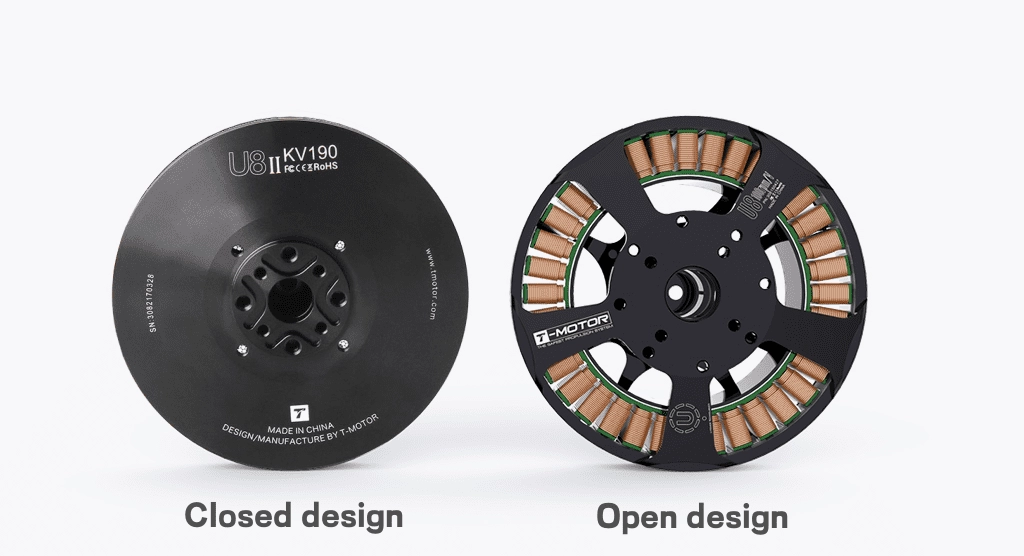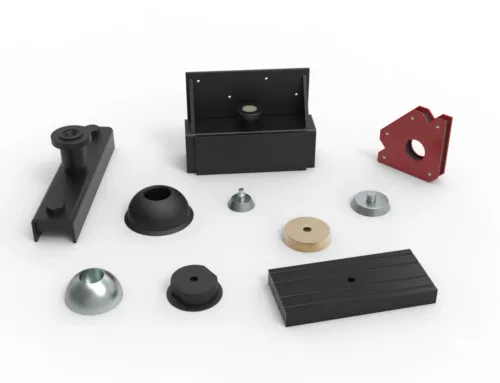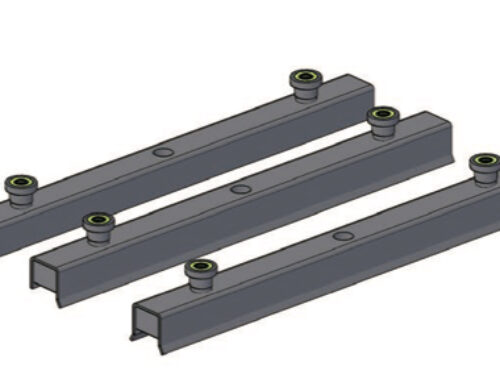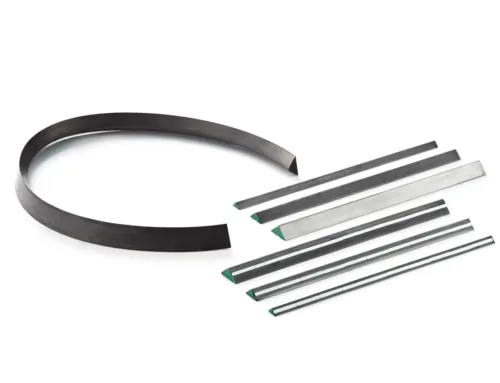Basic Principles of Drone Motors
If you’ve ever wondered how drones take flight, the answer often lies in their motors. A drone motor is the heart of the UAV, converting electrical energy into mechanical motion to spin the propellers and lift the drone.
What is a Drone Motor
A drone motor is an electric motor designed specifically to power drone propellers. Most drones rely on brushless DC motors because of their efficiency, reliability, and lightweight design.
Common Types Used in Drones
- Brushless DC Motors (BLDC): The go-to choice in drones due to their high power-to-weight ratio, low maintenance, and longer lifespan.
- Brushed Motors: Less common now but still used in smaller or budget drones; they have brushes that wear out over time.
Core Functions and How They Work
At the core, drone motors work by generating a rotating magnetic field inside the motor. The brushless motor uses electronic controllers to switch the current in the stator windings, making the rotor spin without physical brushes.
This spinning motion drives the propellers, allowing the drone to:
- Ascend or descend
- Hover steadily
- Maneuver in different directions
How Motor Structure Impacts Performance
The structure of the motor directly influences drone performance. Key factors include:
- Weight: Lightweight motors help extend flight time.
- Precision: Accurate alignment reduces power loss and vibrations.
- Materials: High-quality components improve efficiency, durability, and heat resistance.
- Magnetic design: Effective interaction between stator and rotor magnets boosts torque and responsiveness.
In short, choosing the right motor structure critically shapes how smoothly and efficiently your drone flies.
Detailed Drone Motor Structure

A drone motor is made up of several key parts working together to keep your drone flying smoothly. These main components include the stator, rotor, windings, shaft, bearings, and housing.
- Stator: This is the stationary part of the motor. It holds the windings—coils of wire that create magnetic fields when electricity runs through them.
- Rotor: The rotor spins inside the stator. It usually contains magnets and is the part that actually turns the drone’s propellers.
- Windings: Wrapped around the stator, windings generate magnetic fields that interact with the rotor magnets, causing rotation.
- Shaft: Connected to the rotor, the shaft transfers rotation to the propellers.
- Bearings: These support the shaft and reduce friction, allowing the rotor to spin freely.
- Housing: The outer shell that protects all internal parts and supports the motor structure.
The interaction between the stator and rotor is the heart of the motor’s operation. When current flows through the windings on the stator, they create a magnetic field that pushes and pulls on the rotor’s magnets. This magnetic force makes the rotor spin, turning the shaft and the drone’s propeller.
Precision in building these parts is crucial. High-quality materials and tight tolerances ensure smooth movement, reduce energy loss, and enhance overall drone motor performance. For example, strong rare-earth magnets and durable bearings help lengthen motor life and boost efficiency, which is essential for stable drone flights and longer battery use.
Magnetic Components in Drone Motors
Magnets play a crucial role in drone motors by creating the magnetic field that makes the rotor spin. Without these magnetic components, the motor wouldn’t be able to convert electrical energy into mechanical motion. The most common magnets used in drone motors are neodymium magnets, known for their strong magnetic power and compact size, making them ideal for high-performance drone brushless motor components.
Two key magnetic properties that impact motor performance are coercivity and remanence. Coercivity refers to a magnet’s resistance to losing its magnetic strength when exposed to external magnetic fields or heat. High coercivity ensures the motor maintains efficiency over time, especially under the intense conditions drones face. Remanence is the residual magnetic field a magnet holds after being magnetized, directly affecting the motor’s power output.
The quality of magnetic materials also plays a major role in motor lifespan and heat resistance. Poor-quality magnets can degrade faster, causing reduced efficiency and early motor failure. High-quality neodymium or rare earth magnets offer better thermal stability, ensuring that drone motors run cooler and last longer—an important factor for US drone users who demand reliability during extended flights or in tough weather.
In short, selecting strong, durable magnetic components is key to building efficient, long-lasting drone motors that meet the needs of drone pilots and manufacturers alike.
Magnetic Materials Supplied by NBAEM
NBAEM offers a wide range of magnetic materials tailored for drone motor manufacturers. Their product lineup includes high-quality neodymium magnets, ferrite magnets, and rare-earth alloys — all designed to meet the specific needs of drone brushless motor components.
Manufacturers can customize magnets in terms of size, shape, magnetic strength, and coating to fit different drone motor designs. This flexibility helps optimize stator and rotor performance for better efficiency and reliability.
The key advantages of NBAEM’s magnetic materials include:
- Strong magnetic force for improved motor torque and responsiveness
- Excellent corrosion resistance to withstand harsh environments and extend motor life
- Consistent quality ensuring thermal stability and durability during long flights
By using NBAEM’s magnets, drone makers in the U.S. can build high-performance drone motors that meet the demands of today’s competitive UAV market.
Advances and Innovations in Magnetic Components
Magnetic components in drone motors are seeing exciting advances that boost performance and durability. One major trend is the development of lightweight, high-strength magnets specially designed for drones. These magnets help reduce overall motor weight, which improves flight time and agility—two things every drone pilot values.
Materials like enhanced neodymium magnets now offer stronger magnetic fields without adding bulk. This means better motor efficiency and power output, even in compact drone motor designs. Manufacturers focus on magnets with improved thermal stability too, so motors withstand heat without losing strength or magnetic properties.
Sustainability is also gaining ground. More companies, including NBAEM, are working with eco-friendly magnetic materials and promoting recycling of rare-earth magnets. This approach not only supports environmental goals but also helps secure a reliable supply of critical materials.
In short, these innovations make drone motors smarter, lighter, and longer-lasting while addressing the growing need for sustainable magnet solutions in the US market.
Choosing the Right Magnetic Components for Your Drone Motor
Picking the right magnets for your drone motor is crucial to getting the best performance and durability. There are a few key factors to keep in mind:
- Magnetic strength: Strong magnets like neodymium provide powerful magnetic fields needed for efficient rotor movement and better motor torque.
- Thermal stability: Drones often run hot, so magnets need to resist heat without losing strength or demagnetizing.
- Size constraints: Drone motors come in all shapes and sizes, so magnets must fit perfectly without adding too much weight or bulk.
At NBAEM, we specialize in helping drone motor makers find the ideal magnetic materials. They offer a wide range of neodymium and rare-earth magnets that can be customized in strength, size, and coating to match your design needs. NBAEM’s expertise ensures the magnets are not only powerful but also durable and corrosion resistant—perfect for the tough conditions drones face in the U.S. market.
Practical Considerations in Drone Motor Assembly and Maintenance
Proper assembly and maintenance of drone brushless motor components are key to keeping your drone performing well over time. Here’s what you need to focus on:
Proper Alignment and Magnet Installation
- Correct magnet positioning is crucial. Misaligned magnets can cause uneven magnetic fields, leading to motor vibration, noise, and reduced efficiency.
- Ensure the stator and rotor are perfectly centered to avoid unnecessary friction and wear.
- Use precise tools when installing magnets to prevent damage and maintain their magnetic strength.
Common Issues from Magnetic Component Failures
- Demagnetization: Overheating or impact damage can reduce magnet strength, hurting motor performance.
- Corrosion: Exposure to moisture or rust can degrade magnetic materials, especially if not high-quality.
- Physical damage: Cracked or chipped magnets cause imbalance and abnormal motor behavior.
How to Prevent Magnetic Component Problems
- Avoid overheating motors by monitoring temperature during use and allowing cool-downs.
- Use motors with high-quality magnetic materials like neodymium magnets that offer strong resistance to heat and corrosion.
- Keep motors dry and protected from dust and debris that can cause corrosion or mechanical damage.
Maintenance Tips for Motors with Magnetic Components
- Regularly inspect motors for signs of magnet wear, corrosion, or misalignment.
- Clean the motor housing and magnetic parts carefully using non-abrasive methods.
- Lubricate bearings and shafts properly to reduce stress on magnetic components.
- Replace magnets promptly if any damage is detected to avoid further motor issues.
Handling your drone’s magnetic motor parts with care during assembly and ongoing maintenance ensures longer motor life and consistent drone performance.
Future of Drone Motors and Magnetic Materials
Drone motors are evolving fast, driven by advances in magnetic materials that boost efficiency and durability. As new magnetic compounds emerge, we can expect lighter, more powerful motors that extend flight time and improve performance—key for U.S. drone users who demand reliability and longer battery life.
NBAEM is at the forefront of this shift, developing next-gen neodymium and rare earth magnets tailored specifically for drone brushless motor components. Their focus on high magnetic strength, thermal stability, and corrosion resistance ensures motors can handle tougher conditions without losing power.
Looking ahead, NBAEM aims to support drone manufacturers in creating smarter, more compact motors with custom magnetic solutions. This means better integration with stators and rotors, reducing weight while maximizing thrust. Plus, ongoing research into sustainable and recyclable magnetic materials aligns with growing environmental concerns in the U.S. market.
In short, NBAEM’s innovations in magnetic materials will play a major role in shaping drone motor design, helping U.S. customers achieve higher performance, longer motor life, and greater energy efficiency in their drones.





[…] Each of these applications depends on carefully controlled magnet density to deliver best-in-class performance and meet strict industry standards. For more on magnetic components in motors, check out our guide on understanding drone motor structure and magnetic components. […]